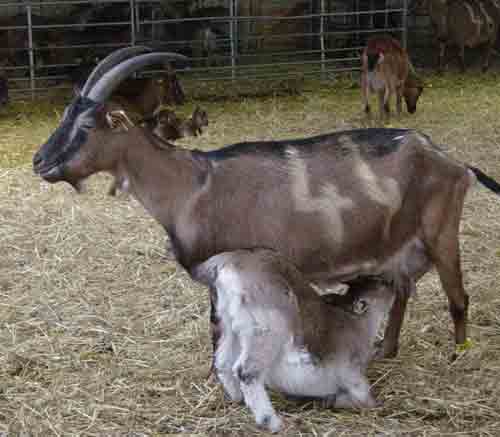The introduction of young dairy goats into an existing herd is stressful for all animals involved.
Rank fights and aggressive behaviour can further result in injury. Researchers at the University of Veterinary Medicine (Vetmeduni Vienna) have found conditions under which young goats can acclimatize into new herds in a relatively low-stress manner. It seems that introduction of young goats into herds works best if kids are present. The results of the study are published in the current issue of the Journal of Dairy Science.
Dairy goats are usually separated from their mothers a few days to weeks after birth and reintroduced into the herd months later – on most farms either in the last months of first pregnancy or shortly after parturition/kidding. The practice is supposed to ensure stable milk production in the herd but it clearly causes stress to the goats. Problems arise because goat herds have a strictly hierarchical social structure and changes in herd composition may lead to serious rivalries and increased aggressive behaviour. Farmers are on the lookout for ways to keep the stress to their animals as low as possible – not only for the sake of the animals but also because stress often results in lower levels of milk production.
Lactating mothers are less stressed
Susanne Waiblinger from the Vetmeduni Vienna’s Institute of Animal Husbandry and Animal Welfare has investigated the social behaviour and levels of stress hormones in 32 young goats following their introduction into a new herd. Half of the animals were introduced during the so-called “dry phase” when all the goats in the herd as well as young goats are pregnant and not giving milk. The other half was introduced shortly after parturition/kidding during the lactating period when mothers were nursing their kids. Waiblinger found that newly introduced goats experienced markedly less social stress in flocks with lactating mothers and goat kids. In “dry” herds, the goats were frequently confronted with aggressive social behaviour. The difference may have a simple physiological explanation. As Waiblinger explains, “We think the oxytocin system is activated in the presence of kids. Oxytocin is released during childbirth, sucking and other positive tactile contact in mammals and acts not only as a bonding hormone but also calming, pro-social and stress-reducing. Thus, it is less likely that there will be aggression between the goats.”
Young goats prefer to stay close to their mates
Once the young goats have been introduced into the new herd, they appear to prefer staying close to other goats of the same age rather than to adult and unknown members of the herd. Waiblinger rationalizes this by noting that “The social and exploratory behaviour in a herd is a reliable indicator of the stress experienced by the animals. When less stressed, goats are more likely to try to become acquainted with unfamiliar adults. Stressed goats prefer to surround themselves with well known peers.” Waiblinger suggests: “It will be interesting to see whether it is the presence of kids or the mother lactating, that plays the crucial role in stress reduction.”
In her scientific work Susanne Waiblinger focusses on the husbandry of small ruminants and cattle and the relationship between animals and humans. She explores how different management practices affect stress and well-being of the farm animals.
If our reporting has informed or inspired you, please consider making a donation. Every contribution, no matter the size, empowers us to continue delivering accurate, engaging, and trustworthy science and medical news. Independent journalism requires time, effort, and resources—your support ensures we can keep uncovering the stories that matter most to you.
Join us in making knowledge accessible and impactful. Thank you for standing with us!

